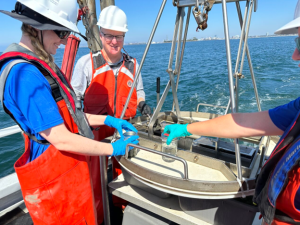Field sampling completed for Bight ’23 Sediment Quality element

The Southern California Bight 2023 Regional Monitoring Program has completed field sampling for its signature Sediment Quality study element – a coordinated, three-month field effort that lays the foundation for participants to collaboratively examine multiple aspects of Southern California’s coastal ocean health, including looking for the presence of multiple, high-priority contaminants of emerging concern (CECs).
The Sediment Quality field sampling, which ran from July to October, involved more than 20 field crews collecting more than 340 sediment grab samples and completing 124 benthic trawls across more than 1,500 square miles of coastal waters, from Point Conception in Santa Barbara County to the U.S.-Mexico border.
The Bight ’23 Sediment Quality study element will add to a nearly three-decade trend line tracking the overall ecological condition of Southern California’s coastal ocean across multiple habitat types. Separately, the Sediment Quality trawl sampling effort will be leveraged to extend a trend line documenting the spread of trash across the coastal seafloor.
The Sediment Quality field sampling effort also will be leveraged to look for the presence of four CECs in seafloor sediment; all of these CECs were identified by a statewide expert CEC advisory panel in spring 2023 as top monitoring priorities:
- Microplastics: Five years ago, microplastics emerged as a statewide legislative priority, paving the way for significant research investments to standardize microplastics monitoring methods. Bight ’23 will use these newly standardized methods to quantify microplastics as small as 125 microns in size in Bight sediment, as well as in shellfish. The new methods represent a monumental advance compared to the methods used to monitor microplastics in sediment during Bight ’13 a decade ago, when the smallest particles to be quantified were 1 millimeter in size.
- PFAS (per- and polyfluoroalkyl substances): California has taken aggressive action in recent years to ban PFAS in clothing and other consumer products, as well as reduce PFAS levels in drinking water. PFAS are a class of chemicals that help make products resistant to heat and stains. Bight ’23 will document what portion of the coastal sediment seafloor is contaminated with PFAS.
- Neonicotinoids: California took legislative action this year to restrict the use of neonicotinoids, the most commonly used pesticide. Bight ’23 will document what portion of the sediment seafloor in Southern California’s embayments is contaminated with neonicotinoids
- Tire wear compounds: In 2020, a research team that included SCCWRP, discovered that a derivative of a chemical used in tire manufacturing – known as 6PPD-quinone – was linked to mass deaths of coho salmon in the Pacific Northwest. Bight ’23 will document what portion of the sediment seafloor in embayments is contaminated with the tire wear compound.
Additionally, because Hurricane Hilary passed through Southern California as a tropical storm in August in the middle of the Sediment Quality sampling period, Bight ’23 will analyze data collected before vs. after the storm to evaluate if interpretation of sediment quality conditions will be affected.
Across Southern California, much of what environmental managers know about how land-based contamination has impacted overall coastal ocean health has come from the Bight program’s Sediment Quality element.
The Sediment Quality assessment uses multiple lines of evidence to provide greater confidence in its findings. For example, the program uses a quantitative scoring tool to synthesize three main lines of evidence – sediment toxicology, sediment chemistry, and sediment-dwelling biological community health – to produce a single category score reflecting sediment quality.
Bight ’23 program participants already have begun conducting chemical and biological analyses of sediment samples. Technical committees will reconvene over the next year to review results and prepare assessment reports detailing their findings.
For more information, contact Dr. Karen McLaughlin.
More news related to: Emerging Contaminants, Regional Monitoring, Sediment Quality, Southern California Bight Regional Monitoring Program, Top News, Trash Pollution